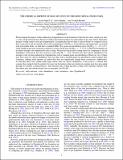THE CHEMICAL IMPRINT OF SILICATE DUST ON THE MOST METAL-POOR STARS
Author(s)
Bromm, Volker; Ji, Alexander Pung; Frebel, Anna L.
DownloadJi-2014-The chemical imprint.pdf (1016.Kb)
PUBLISHER_POLICY
Publisher Policy
Article is made available in accordance with the publisher's policy and may be subject to US copyright law. Please refer to the publisher's site for terms of use.
Terms of use
Metadata
Show full item recordAbstract
We investigate the impact of dust-induced gas fragmentation on the formation of the first low-mass, metal-poor stars (<1 M[subscript ☉]) in the early universe. Previous work has shown the existence of a critical dust-to-gas ratio, below which dust thermal cooling cannot cause gas fragmentation. Assuming that the first dust is silicon-based, we compute critical dust-to-gas ratios and associated critical silicon abundances ([Si over H][subscript crit]). At the density and temperature associated with protostellar disks, we find that a standard Milky Way grain size distribution gives [Si over H][subscript crit] = –4.5 ± 0.1, while smaller grain sizes created in a supernova reverse shock give [Si over H][subscript crit] = –5.3 ± 0.1. Other environments are not dense enough to be influenced by dust cooling. We test the silicate dust cooling theory by comparing to silicon abundances observed in the most iron-poor stars ([Fe over H] < -4.0). Several stars have silicon abundances low enough to rule out dust-induced gas fragmentation with a standard grain size distribution. Moreover, two of these stars have such low silicon abundances that even dust with a shocked grain size distribution cannot explain their formation. Adding small amounts of carbon dust does not significantly change these conclusions. Additionally, we find that these stars exhibit either high carbon with low silicon abundances or the reverse. A silicate dust scenario thus suggests that the earliest low-mass star formation in the most metal-poor regime may have proceeded through two distinct cooling pathways: fine-structure line cooling and dust cooling. This naturally explains both the carbon-rich and carbon-normal stars at extremely low [Fe over H].
Date issued
2014-02Department
Massachusetts Institute of Technology. Department of Physics; MIT Kavli Institute for Astrophysics and Space ResearchJournal
Astrophysical Journal
Publisher
IOP Publishing
Citation
Ji, Alexander P., Anna Frebel, and Volker Bromm. “THE CHEMICAL IMPRINT OF SILICATE DUST ON THE MOST METAL-POOR STARS.” The Astrophysical Journal 782, no. 2 (February 3, 2014): 95. © 2014 The American Astronomical Society
Version: Final published version
ISSN
0004-637X
1538-4357